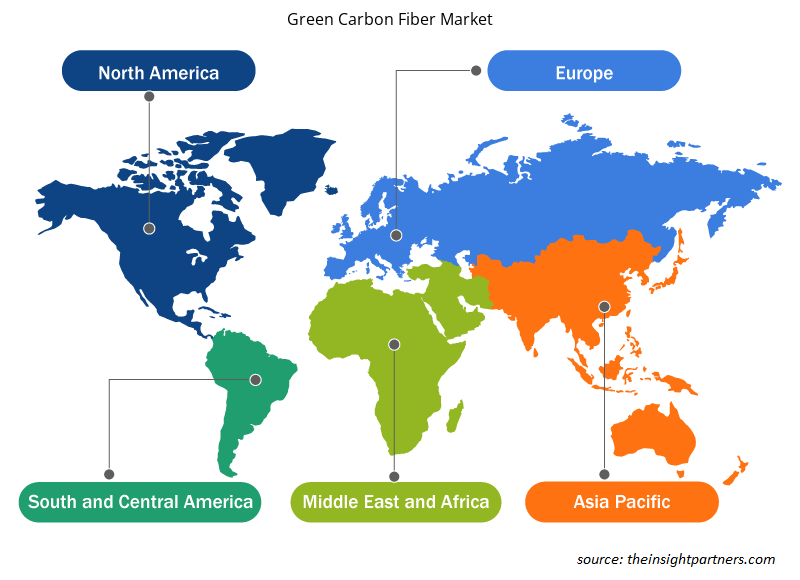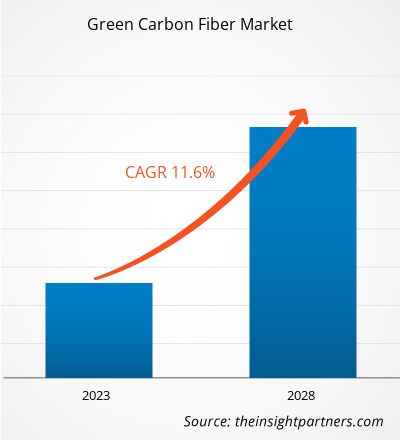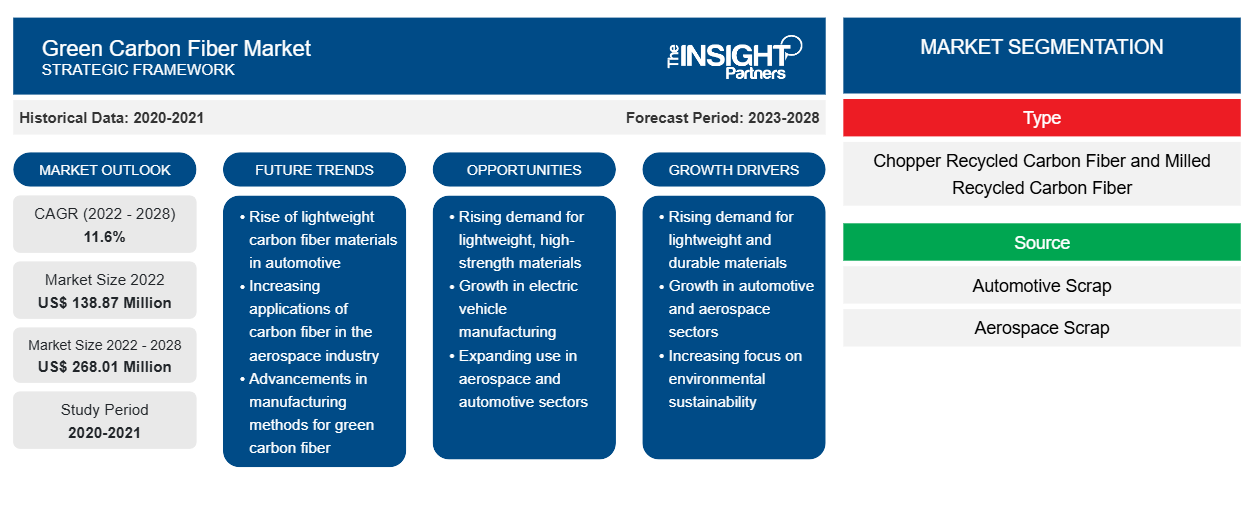[Rapporto di ricerca] Il mercato della fibra di carbonio verde è stato valutato a 138,87 milioni di dollari nel 2022 e si prevede che raggiungerà i 268,01 milioni di dollari entro il 2028; si prevede che registrerà un CAGR dell'11,6% dal 2022 al 2028.
La fibra di carbonio verde è una fibra di carbonio riciclata. Il riciclaggio della fibra di carbonio è un recupero di fibre da compositi rinforzati con fibra di carbonio (CFRC). Esistono due tipi di rifiuti di fibra di carbonio. Il primo tipo di rifiuto è la fibra di carbonio vergine, scarti del prodotto generato dalla fibra secca e dal materiale scaduto non utilizzato, che sono anche chiamati scarti. La fibra di carbonio verde o riciclata viene utilizzata per produrre nuove parti ad alte prestazioni in vari settori di utilizzo finale. I vantaggi della fibra di carbonio verde, insieme alla crescente domanda di materiali economici e leggeri da vari settori di utilizzo finale come l'automotive, l'aerospaziale, l'energia eolica, gli articoli sportivi, ecc., stanno rafforzando la crescita del mercato delle fibre di carbonio verdi.
Nel 2022, l'Asia Pacifica ha detenuto la quota maggiore del mercato globale della fibra di carbonio verde e si stima che l'Europa registrerà il CAGR più elevato durante il periodo di previsione. Il mercato della fibra di carbonio verde dell'Asia Pacifica è segmentato in Cina, Giappone, India, Corea del Sud, Australia e resto dell'Asia Pacifica. L'industria aerospaziale e della difesa nell'Asia Pacifica è cresciuta in modo significativo negli ultimi anni. Nell'Asia Pacifica, la Cina è uno dei maggiori produttori di aeromobili e uno dei maggiori mercati per i passeggeri aerei nazionali.
Personalizza questo report in base alle tue esigenze
Riceverai la personalizzazione gratuita di qualsiasi report, comprese parti di questo report, o analisi a livello nazionale, pacchetto dati Excel, oltre a usufruire di grandi offerte e sconti per start-up e università
-
Scopri le principali tendenze di mercato in questo rapporto.Questo campione GRATUITO includerà analisi di dati che spaziano dalle tendenze di mercato alle stime e alle previsioni.
Impatto della pandemia di COVID-19 sul mercato della fibra di carbonio verde
I paesi dell'Asia Pacifica, come Cina, India e Giappone, hanno dovuto affrontare sfide significative a causa della chiusura delle unità produttive, dell'interruzione delle catene di fornitura e della carenza di materie prime durante la pandemia di COVID-19; ciò ha provocato un enorme crollo nella produzione e distribuzione dei prodotti. Tuttavia, la pandemia ha anche portato alcune opportunità redditizie per i principali attori che operano nel mercato della fibra di carbonio verde nell'Asia Pacifica. Molte aziende nel mercato della fibra di carbonio verde hanno iniziato a implementare protocolli e norme governative per vendere i loro prodotti durante o dopo la seconda ondata di COVID-19 per cogliere questa opportunità e aumentare le vendite. Quindi, le approvazioni da parte dei governi tendono ad aumentare la domanda di fibre di carbonio sostenibili, aumentando la crescita del mercato della fibra di carbonio verde.
Approfondimenti di mercato
L'aumento dell'uso della fibra di carbonio verde nel settore dell'energia eolica stimola il mercato della fibra di carbonio verde
La domanda di turbine eoliche sta aumentando rapidamente poiché vari paesi in tutto il mondo stanno passando dai combustibili fossili non rinnovabili e dannosi per il clima a fonti di energia pulite e rinnovabili. Inoltre, l'aumento del prezzo dell'elettricità sta spingendo la necessità di fonti di energia rinnovabili. Il mercato dell'energia eolica sta crescendo poiché i governi di vari paesi come Stati Uniti, Germania, Arabia Saudita e Cina stanno prendendo iniziative per produrre energia rinnovabile. Un aumento della domanda di fonti di energia rinnovabile, in particolare energia eolica, e gli sforzi per ridurre la dipendenza dalla generazione di energia basata sui combustibili fossili sono fattori significativi per la crescita del segmento dell'energia eolica, alimentando infine la crescita del mercato della fibra di carbonio verde.
I polimeri rinforzati con fibre di carbonio vergini (VCF) vengono utilizzati per realizzare i cappucci delle pale delle turbine eoliche, mentre i polimeri con fibre di vetro vengono utilizzati per realizzare le pelli dei componenti delle pale. Tuttavia, la fibra di carbonio verde è ora ampiamente utilizzata nelle turbine eoliche, poiché le pale ibride in fibra di carbonio riciclata offrono prestazioni ambientali migliori del 12-89%. I tempi di ammortamento energetico e di carbonio per le pale ibride in fibra di carbonio riciclata sono stati inferiori del 5-13% rispetto a quelli degli operatori storici del mercato. L'utilizzo di fibre di carbonio riciclate per le parti delle pale delle turbine eoliche può essere fattibile dal punto di vista meccanico e offrire significativi vantaggi ambientali rispetto alle fibre di vetro. Queste proprietà caratteristiche della fibra di carbonio hanno contribuito a produrre turbine eoliche migliori e una maggiore produzione di energia. Pertanto, il crescente utilizzo di fibre di carbonio verdi nel settore dell'energia eolica sta stimolando la crescita del mercato.
Informazioni basate sul tipo
In base al tipo, il mercato della fibra di carbonio verde è diviso in fibra di carbonio riciclata chopper e fibra di carbonio riciclata macinata. Il segmento della fibra di carbonio riciclata macinata ha detenuto una quota maggiore del mercato nel 2022. La fibra di carbonio riciclata macinata è realizzata macinando la fibra tagliata in una polvere (macinata). La lunghezza usuale della fibra di carbonio riciclata macinata è di 80-100 micrometri. Queste fibre offrono dissipazione elettrostatica e resistenza.
Approfondimenti basati sulla fonte
In base alla fonte, il mercato della fibra di carbonio verde è segmentato in rottami automobilistici, rottami aerospaziali e altri. Si prevede che il segmento dei rottami automobilistici registrerà il CAGR più elevato durante il periodo di previsione. Le fibre di carbonio riciclate possono essere ottenute da circa il 40-60% del volume di rottami derivanti dalla produzione di plastica rinforzata con fibra di carbonio (CFRP) per uso automobilistico. L'utilizzo di fibre di carbonio riciclate può aiutare i produttori di automobili a ottenere più chilometri dal veicolo.
Approfondimenti basati sulle applicazioni
In base all'applicazione, il mercato della fibra di carbonio verde è segmentato in aerospaziale, automobilistico, energia eolica, articoli sportivi e altri. Il segmento automobilistico ha rappresentato la quota di mercato maggiore nel 2022. L'industria automobilistica utilizza frequentemente fibre di carbonio riciclate per realizzare pannelli del telaio, pavimenti, pannelli del tetto, vani ruota di scorta e interni del bagagliaio o del cofano.
L'azienda utilizza un processo a ciclo chiuso per il riciclaggio delle fibre di carbonio secche. Il costo di produzione delle automobili che utilizzano fibre di carbonio riciclate è relativamente inferiore al costo di produzione dell'acciaio. Inoltre, le fibre di carbonio riciclate possono essere modellate e modellate in forme diverse, il che non avviene con l'acciaio. Queste proprietà delle fibre di carbonio riciclate stanno rafforzando la loro domanda nel settore automobilistico.
I principali attori che operano nel mercato della fibra di carbonio verde includono Procotex Corp SA, Vartega Inc, Sigmatex (UK) Ltd, Shocker Composites LLC, Carbon Conversions Co, SGL Carbon SE, Toray Industries Inc, Gen 2 Carbon Ltd, Catack-H Co Ltd e Innovative Recycling. Queste aziende si stanno concentrando sul lancio di nuovi prodotti e sulle espansioni geografiche per soddisfare la crescente domanda dei consumatori in tutto il mondo. Hanno una presenza globale diffusa, che consente loro di servire un ampio gruppo di clienti e di conseguenza aumenta la loro quota di mercato. Questi attori di mercato si concentrano fortemente sul lancio di nuovi prodotti e sulle espansioni regionali per aumentare la loro gamma di prodotti nei portafogli specializzati.
Approfondimenti regionali sul mercato della fibra di carbonio verde
Le tendenze regionali e i fattori che influenzano il Green Carbon Fiber Market durante il periodo di previsione sono stati ampiamente spiegati dagli analisti di Insight Partners. Questa sezione discute anche i segmenti e la geografia del Green Carbon Fiber Market in Nord America, Europa, Asia Pacifico, Medio Oriente e Africa e Sud e Centro America.

- Ottieni i dati specifici regionali per il mercato della fibra di carbonio verde
Ambito del rapporto sul mercato della fibra di carbonio verde
| Attributo del report | Dettagli |
|---|---|
| Dimensioni del mercato nel 2022 | 138,87 milioni di dollari USA |
| Dimensioni del mercato entro il 2028 | 268,01 milioni di dollari USA |
| CAGR globale (2022 - 2028) | 11,6% |
| Dati storici | 2020-2021 |
| Periodo di previsione | 2023-2028 |
| Segmenti coperti |
Per tipo
|
| Regioni e Paesi coperti |
America del Nord
|
| Leader di mercato e profili aziendali chiave |
|
Densità degli attori del mercato della fibra di carbonio verde: comprendere il suo impatto sulle dinamiche aziendali
Il mercato del Green Carbon Fiber Market sta crescendo rapidamente, spinto dalla crescente domanda degli utenti finali dovuta a fattori quali l'evoluzione delle preferenze dei consumatori, i progressi tecnologici e una maggiore consapevolezza dei benefici del prodotto. Con l'aumento della domanda, le aziende stanno ampliando le loro offerte, innovando per soddisfare le esigenze dei consumatori e capitalizzando sulle tendenze emergenti, il che alimenta ulteriormente la crescita del mercato.
La densità degli operatori di mercato si riferisce alla distribuzione di aziende o società che operano in un particolare mercato o settore. Indica quanti concorrenti (operatori di mercato) sono presenti in un dato spazio di mercato in relazione alle sue dimensioni o al valore di mercato totale.
Le principali aziende che operano nel mercato della fibra di carbonio verde sono:
- Società Procotex SA
- Vartega Inc
- Sigmatex (Regno Unito) Ltd
- Compositi Shocker LLC
- Conversioni di carbonio Co
Disclaimer : le aziende elencate sopra non sono classificate secondo un ordine particolare.

- Ottieni una panoramica dei principali attori del mercato della fibra di carbonio verde
Segnala i riflettori
- Tendenze industriali progressive nel mercato della fibra di carbonio verde per aiutare le aziende a sviluppare strategie efficaci a lungo termine
- Strategie di crescita aziendale adottate dagli operatori del mercato nei paesi sviluppati e in via di sviluppo
- Analisi quantitativa del mercato dal 2022 al 2028
- Stima della domanda globale di fibra di carbonio verde
- Analisi delle cinque forze di Porter per illustrare l'efficacia di acquirenti e fornitori nel mercato della fibra di carbonio verde
- Sviluppi recenti per comprendere lo scenario competitivo del mercato
- Tendenze e prospettive di mercato, fattori trainanti e limiti della crescita nel mercato della fibra di carbonio verde
- Assistenza nel processo decisionale evidenziando le strategie di mercato che sostengono l'interesse commerciale
- Dimensioni del mercato della fibra di carbonio verde in vari nodi
- Una panoramica dettagliata e le dinamiche del settore della fibra di carbonio verde
- Dimensioni del mercato della fibra di carbonio verde in varie regioni con promettenti opportunità di crescita
- Analisi storica (2 anni), anno base, previsione (7 anni) con CAGR
- Analisi PEST e SWOT
- Valore/volume delle dimensioni del mercato - Globale, Regionale, Nazionale
- Industria e panorama competitivo
- Set di dati Excel
Report recenti
Rapporti correlati
Testimonianze
Motivo dell'acquisto
- Processo decisionale informato
- Comprensione delle dinamiche di mercato
- Analisi competitiva
- Analisi dei clienti
- Previsioni di mercato
- Mitigazione del rischio
- Pianificazione strategica
- Giustificazione degli investimenti
- Identificazione dei mercati emergenti
- Miglioramento delle strategie di marketing
- Aumento dell'efficienza operativa
- Allineamento alle tendenze normative























 Ottieni un campione gratuito per - Mercato della fibra di carbonio verde
Ottieni un campione gratuito per - Mercato della fibra di carbonio verde